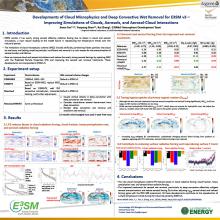Improving simulations of clouds and aerosol-cloud interactions in E3SM with New cloud microphysics and deep convective wet removal treatments
Jiwen
Fan
Argonne National Laboratory
Poster
Simulating clouds and aerosol-cloud interactions (ACI) in climate models remains a significant challenge, and ACI continues to represent the largest source of uncertainty in climate prediction. The Department of Energy’s Energy Exascale Earth System Model (E3SM) version 2, for instance, has significant limitations in cloud microphysics parameterization and large biases in simulating liquid and ice water path, overestimates aerosol burden and lifetime, and predicts overly strong aerosol effective radiative forcing. To address these biases in version 3, we implemented a new cloud microphysics scheme, Predicted Particle Properties (P3), as well asimproved treatments of aerosol wet removal, to enhance simulations of clouds, aerosols, and ACI forcing. Our results show that, compared to the original Morrison-Gettelman (MG2) scheme, P3 improves shortwave cloud radiative forcing by over 1 W m⁻² and reduces aerosol forcing by 0.17 W m⁻² on a global mean basis. By improving aerosol wet removal treatments, particularly for deep convective clouds, we substantially reduce aerosol burden and lifetime, correcting positive biases in aerosol optical depth and aerosol mass concentration. As a result, both the direct and indirect components of total aerosol forcing and the bias in the top-of-atmosphere (TOA) radiation budget are significantly reduced. These improvements greatly contribute to E3SM v3's capability of reproducing surface temperature trends during the industrial period, a goal that previous versions of the model struggled to achieve.

Fan-Jiwen-poster.pdf
(2.2 MB)
Meeting homepage
